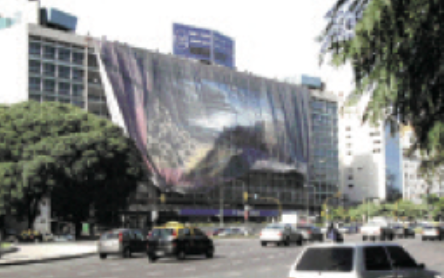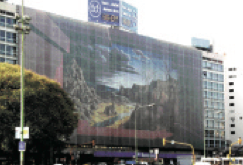Arte en el Plata
Public art, Del Plata Building
Impossible to ignore and really impressive, the four artistic interventions featuring gigantographs of works by up-and-coming contemporary artists on the façade of the Del Plata Building managed to transfer images which are habitually viewed in more intimate venues, such as museums and private collections, to the public sphere. For over a year now, the sur- face of the one-hundred-meter front façade of the Del Plata Building ─ formerly, the Del Plata Market, inaugurated in 1962 ─ has been favor- ably modified through the work of Fabián Burgos, Guillermo Ueno, Max Gómez Canle and Marcos López. The building is situated just steps away from the Obelisco, nerve center of Buenos Aires City, on 9 de Julio Avenue (according to the inhabitants of Buenos Aires, the widest avenue in the world), at its intersection with the famous Corrientes Avenue.

Arte en el Plata has different meanings for each of the partici- pants in the project. While for the curators, Eva Grinstein and Inés Katzenstein, it offers “an opportunity for artistic and cura- torial experimentation”, the artists consider it a distinction and also a challenge, due to the change in the scale of the works. For the City’s authorities – Fundación Banco Ciudad, Ministry of Culture and Ministry of the Environment and Public Spaces ─ it provides the chance to put a larger number of people in contact with contemporary art, and to highlight the importance of and commitment to public art and to the generation of city land- marks in “the great capital of cultural tourism,” as the Minister for Culture, Hernán Lombarda, pointed out. The gigantographs, printed on microperforated vinyl tarp (commonly known as mesh), reach 34 meters in height and 88 meters in length, and they occupy 2,990 square meters. These images invade one of the busiest avenues in a nervous and densely populated urban cen- ter, inviting the viewers, hurried pedestrians and agitated drivers to get a glimpse of a different instant, of the experience of observing an artistic image. Firstly, in October 2008, an inven- tive montage team installed Velocidad, the work by Fabián Burgos (Buenos Aires, 1962). Light and vibration, repetitions of forms and color shadows generated movement in the painting, which offered trompe-l’oeil effects in the geometric abstractions with optic relationships, challenging the viewer’s perception.
Later, in March 2009, it was the turn of Siesta, by Guillermo Ueno (Buenos Aires, 1968), the picture of a young woman sleeping in the midst of the urban landscape, which was received with mixed reactions. While some people perceived it as a peaceful backwater, others saw a “sleeping beauty”, dis- connected from the praxis of the present-day woman living in Buenos Aires, who works, militates and nurtures a healthy fam- ily. The work showcased in July was Ventana, by Max Gómez Canle (Buenos Aires, 1972), who uses in his painting trimmed frames of different shapes – in the manner of the Madi move- ment ─ to compose a landscape that includes magnificent and disturbing skies and rock formations or mountains, which are perhaps dramatic and definitively neo-romantic.
Terraza, by the photographer Marcos López (Santa Fe province, 1958), has been on exhibit since October. The artist gleans unexpected images from the obvious and constructs improba- ble portraits depicting moments that are more real than life. He has a privileged eye to discover the main figures ─ some of whom resemble, in this case, the mythical Carlos Gardel and Isabel Sarli – of his singular misesen scene: for instance, a very typical porteño barbecue on the roof-top, against the background of the Avellaneda Bridge in La Boca.
The successive artistic interventions featured on the façade of what is currently the headquarters of different technical and administra- tive departments of the Government of the Autonomous City of Buenos Aires has generated debate and has been profusely record- ed in the newspapers, which generally look favorably upon this bold initiative.





